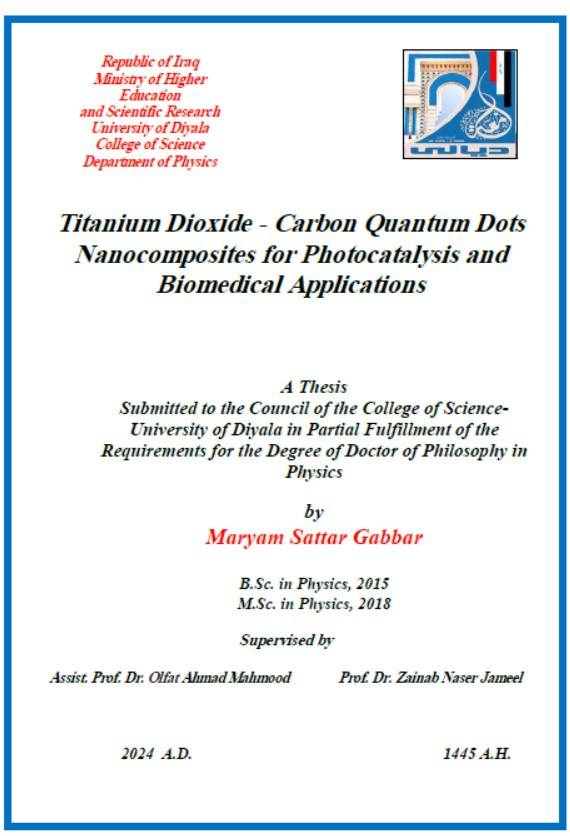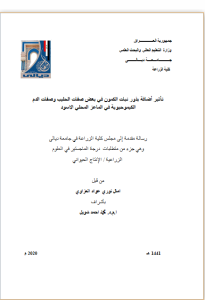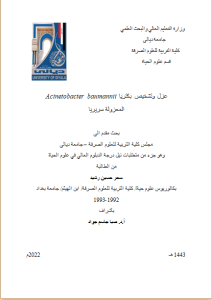Abstract
In this study, titanium dioxide (TiO2) nanoparticles were prepared using the (sol-gel) method, and the prepared material was calcined at two temperatures (450 °C ) to obtain the Anatase phase and (850 °C) to obtain the Rutile phase of the nanoparticles. Then, carbon quantum dots (CQDs) were prepared using the (green method) at a temperature (130 °C), and then TiO2-CQDs nanocomposites with different weight percentages of CQDs were prepared by heat treatment at (80 °C).
The structural (X-Ray Diffraction (XRD), Fourier Transform Infrared Instruments (FTIR), Energy Dispersive X-Ray Spectroscopy (EDS), morphological (Field Emission-Scanning Electron Microscopes (FE-SEM), High Resolution- Transmission Electron Microscopy (HR-TEM) and optical (UV–Visible) properties were studied.
XRD test showed that, the Anatase phase of TiO2 at (450 °C) has a polycrystalline nature with a tetragonal structure and the preferred orientation (101), while the Rutile phase of TiO2 at (850 °C) has a polycrystalline nature with a tetragonal structure and the preferred orientation (110). The results also showed that, CQDs has a broad peak at (200) and a hexagonal structure. The crystalline size of the prepared materials was calculated using the Scherrer’s formula, where the crystalline size values were (40.54, 15.89) nm for the Anatase and Rutile phases. respectively, and (1.28 nm) for CQDs.
The (FTIR) analysis revealed the appearance of the basic peaks of a substance TiO2 NPs of (Ti–O bending, Ti–O–Ti bending) for Anatase and Rutile phases, and the intensity of the peaks increases with to the rise in temperature. While the permeability curve from (FTIR) of CQDs shows the presence (C-C stretching, C-O-C stretching C=C stretching), and these peaks are basic for carbon material. From results (FTIR) of the TiO2-CQDs nanocomopsites showed that, the peaks intensity increases with the increase in the percentage of CQDs in samples, and the resulting peaks of the nanocomopsites are a mixture of peaks of pure elements, this is evidence that the resulting materials are composite materials.
The results of (FE-SEM) showed that the surface of Anatase phase is made up of nanograins arranged regularly with a cauliflower -like shape. And Rutile phase grains appear in the form of irregular shapes, The average grain size is equals (36.9, 58) nm for Anatase and Rutile phases, respectively. While the CQDs has nanostructures in the form of small grains that are grouped together forming cloud-like .
HR-TEM results showed that, the Anatase phase consists of spherical-shaped nanoparticles with particle size less than (15 nm), the Rutile phase granules growing in different shapes and gathering together to form one larger shapewith particle size of less than (25nm). And the CQDs had a relatively uniform, dot-like spherical shape with particle size of less than (5 nm).
For optical properties, absorbance was measured in the range of (300 – 900) nm for all samples, The optical energy gap for the permissible direct electronic transfer was calculated using the Tauc relationship and the results showed that, the optical energy gap are (3.14 , 2.7) eV Anatase and Rutile phases, respectively. And its value of CQDs equal (3.07 eV). While the optical energy gap values of TiO2-CQDs nanocomposites decreased within the range (2.97-1.85) eV with increasing CQDs rate.
This study also included two applications of the prepared nanoma-terials. In the physical application, the photocatalytic effect of Anatase phase nanomaterials of TiO2 and TiO2-CQDs nanocomposites on the decomposition of dyes Methylene Blue (MB) and Methyl Orange (MO) in the presence of UV light was studied. The results showed that when the irradiation time was increased from (0 min) to (240 min), the intensity of the absorbance peaks for all samples witnessed a significant decrease as the color of the dyes faded. The photocatalytic efficiency also improved when CQDs were added to the Anatase phase, and the photodegradation efficiency increased with an increase in the percentage of CQDs in the TiO2 – CQDs nanocomposites. The highest decomposition efficiency for (MB and MO) dyes was (84% and 39%) at 240 min, respectively.
In biomedical application, the Anatase and Rutile phases of TiO2 and TiO2-CQD nanocomposites were tested on two cell lines, the cancer line Human Hepatocellular Carcinoma (HepG2) and the normal cell line Rhabdomyosarcoma (RD) for 24 hours. The results showed that nanoma-terials have little effect on RD compared to their effect on inhibition of the HepG2 cell line, and the Anatase phase has a higher rate of inhibition of cell lines compared to the rates of inhibition by the Rutile phase. From the results, it was found that the TiO2-CQDs nanocomposites have a higher rate of inhibition of HepG2 and RD cell lines compared to the two phases of titanium dioxide, and it increases with the increase in the percentage of CQDs.





